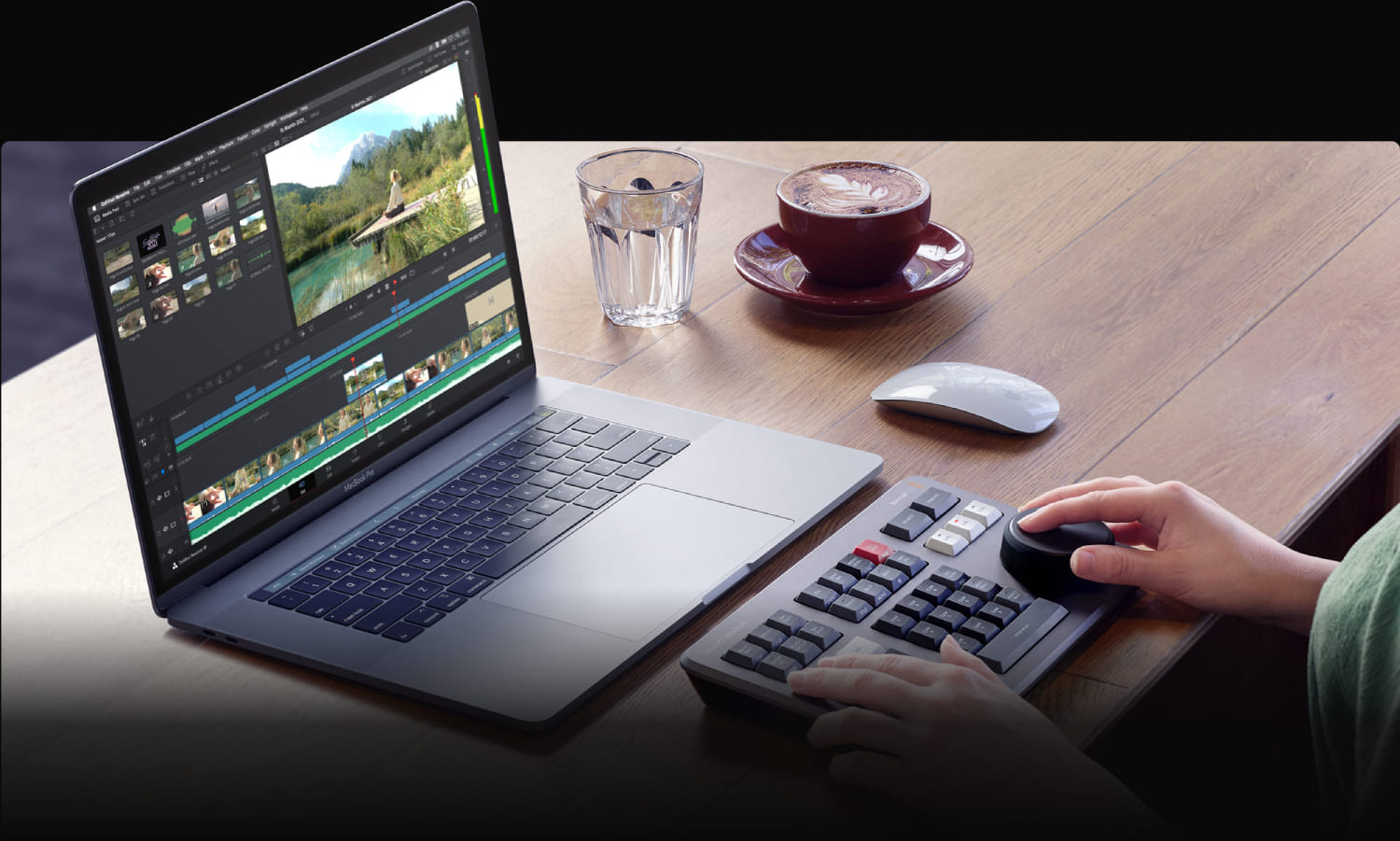DaVinci Resolve vs Final Cut Pro: Which One Is Right for You?
Within the Mac world, DaVinci Resolve and Final Cut Pro are the top tools for professional video editing. They differ in features, workflows, and intended uses. So, if you edit videos on a Mac, you might wonder whether to choose DaVinci Resolve or Final Cut Pro.
In this article, we discuss the latest industry trends and user feedback. We also break down key features, learning curves, and collaboration options to help you decide which tool best suits your needs.

In this article, you will learn:
- DaVinci Resolve vs Final Cut Pro: Core Features Comparison
- DaVinci Resolve vs Final Cut Pro: Learning Curve and User Suitability
- DaVinci Resolve vs Final Cut Pro: Stability and Collaboration
- DaVinci Resolve vs. Final Cut Pro: AI Automation
- DaVinci Resolve vs Final Cut Pro: Which One Should You Choose?
DaVinci Resolve vs Final Cut Pro: Core Features Comparison
1. Color Grading & Visual Effects
DaVinci Resolve:
- Top-Tier Color Grading: Its node-based grading system lets you do multi-layer color correction, mask tracking, and HDR grading. It's the official color tool for Hollywood films like Dune and Oppenheimer.
- Integrated Fusion Module: You can create 3D composites and particle effects right on the timeline. No need to switch apps, and it supports OpenFX plugins.
- AI Tools: In 2025, a new AI scene recognition feature was added. It automatically separates the foreground and background, boosting green screen keying efficiency by over 30%.
Final Cut Pro:
- Basic Color Grading: It offers color wheels and curve adjustments, which are enough for most tasks. However, it lacks advanced mask tracking and HDR grading.
- Motion Plugin Support: To create motion graphics, you need to buy Motion separately, which makes the workflow less seamless.
2. Editing Efficiency & Workflow
DaVinci Resolve:
- Multiple Workspaces: It has separate pages for Editing (Cut / Edit), Color, and Audio (Fairlight). This setup works well for team projects but requires switching between pages.
- Optimized Proxy Workflow: It automatically creates low-res proxy files so you can smoothly edit 4K projects even on a slim laptop like the M2 MacBook Air.
Final Cut Pro:
- Magnetic Timeline: This feature snaps clips together and removes gaps automatically. It's great for fast rough cuts and syncing multiple camera angles, and tests show it boosts editing speed by about 40% compared to a traditional timeline.
- Library Management: It tightly integrates with macOS and supports iCloud sync, making it ideal for solo creators working across different devices.

DaVinci Resolve vs Final Cut Pro: Learning Curve and User Suitability
1. Ease of Use for Beginners
DaVinci Resolve:
- Steep Learning Curve: Advanced features like node-based color grading and Fusion compositing require at least 20 hours of study. Most tutorials are in English, and there are few resources in other languages.
- Free Version Limitations: The free version lacks key features like HDR grading and multi-user collaboration. You need to spend $295 on the Studio version to unlock them.
Final Cut Pro:
- Intuitive Interface: The buttons are clearly laid out. About 90% of basic tasks are done with drag and drop, so beginners can learn the basics in around 3 hours.
- Built-In Tutorials and Templates: It comes with hundreds of presets for titles, transitions, and music packs, making it great for creators who need to quickly put together short videos.
2. Hardware Compatibility
DaVinci Resolve:
- High GPU Demands: It needs at least 8GB of VRAM (like on an M1 Max or better) to run Fusion effects smoothly.
Final Cut Pro:
- Optimized for Apple Silicon: It renders 2.5 times faster on Apple's M series chips (like M2, M3, and M4) than on older Macs with Intel processors, and it uses 40% less power.

DaVinci Resolve vs Final Cut Pro: Stability and Collaboration
1. System Stability
DaVinci Resolve:
- Since version 18.6, its stability has improved a lot. However, complex effects projects might still have choppy previews, so you need to clear the render cache often.
Final Cut Pro:
- With deep macOS integration, it crashes less than 0.5% of the time. This makes it a great choice for long, heavy projects like feature-length documentaries.
2. Team Collaboration
DaVinci Resolve:
- Multiple users can work on the same project at the same time. Colorists, editors, and sound mixers can all work together, making it ideal for movie-level teams.
Final Cut Pro:
- It does not have built-in support for multiple users. You have to use third-party plugins like Frame.io for remote reviews, which makes teamwork less efficient.

DaVinci Resolve vs. Final Cut Pro: AI Automation
First, we must be clear: AI automation is a big challenge for editors. Tasks like cutting, color grading, and matching audio are becoming automated.
But no matter how far technology goes, an editor's creative judgment and storytelling remain unique — something AI cannot copy. AI tools can handle some tasks automatically, but they simply add to the editor's toolkit. They let editors focus on telling a story instead of doing all the technical work.
When it comes to adding AI features, both DaVinci Resolve and Final Cut Pro follow a similar approach. They keep the unique, personal touch of editing instead of over-simplifying the creative process like Adobe does with Premiere Pro.
For now, both programs focus on giving users control instead of relying solely on AI automation. No matter which software you use, you can enjoy AI help while still feeling like you are in full charge of your creative work.
If you love the hands-on feel of video editing and want to work faster, TourBox could be a great choice for you.

TourBox makes every step of editing easier. You won't have to struggle with moving the playhead or zooming the timeline. With just one hand, you can feel in control of your creative process.
Click on our video editing page to learn more about TourBox. And if you usually edit on an iPad, TourBox Elite Plus might be the perfect tool for you.

DaVinci Resolve vs Final Cut Pro: Which One Should You Choose?
After looking at these two video editing programs in detail, the question is: which one should you pick?
We suggest you decide based on your own needs and situation. Feel free to reference the table below for a direct answer.
| User Type | Recommended Software | Core Strengths |
|---|---|---|
| Individual Creators / Short Videos | Final Cut Pro | Fast turnaround, lots of templates, and smooth integration with macOS. |
| Professional Colorists / Film Teams | DaVinci Resolve | Hollywood-level color grading, easy team collaboration, and all-in-one visual effects. |
| Cross-platform Users | DaVinci Resolve | Works on Windows, Linux, and macOS with highly compatible project files. |
| Beginners on a Budget | DaVinci Resolve | The free version meets most video editing needs. |
| Users Who Value Ease of Use and Stability | Final Cut Pro | It offers a better editing experience on Apple hardware than DaVinci Resolve. |
If you prefer free editing software, the free version of DaVinci Resolve will cover most of your needs.
If you're ready to pay, there's no price gap between DaVinci Resolve and Final Cut Pro. Both are available as one-time purchases, so you pay once and use them for life.
This means you can choose based on your personal experience. For example, if you want top-notch color grading and effects, choose DaVinci Resolve. But if you value fast editing and seamless integration with Apple devices, go with Final Cut Pro.
We recommend trying both for free — download the free version of DaVinci Resolve and use Final Cut Pro's one-month trial — so you can test them on real projects before deciding.